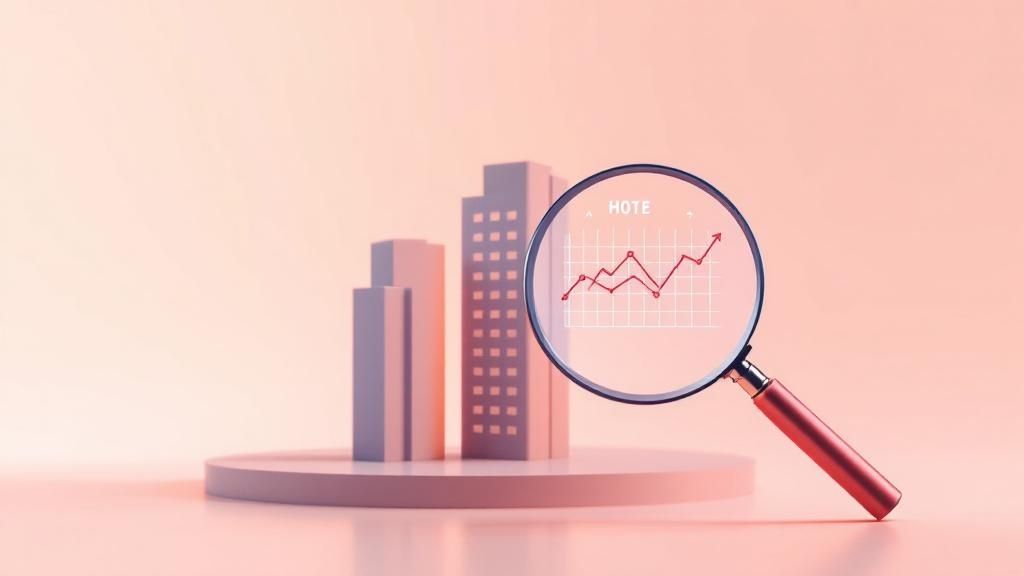In the competitive landscape of the hospitality industry, mastering the art and science of pricing is paramount. Effective hotel revenue management strategies are no longer a luxury for large chains but a necessity for properties of all sizes aiming for sustainable growth and maximized profitability. Moving beyond simple occupancy metrics, today's leaders focus on optimizing Revenue Per Available Room (RevPAR) and total revenue through a sophisticated blend of data-driven tactics, technological innovation, and effective digital marketing strategies.
This guide serves as a professional yet accessible roadmap, demystifying the core components of modern revenue management. We will explore eight powerful, actionable strategies designed to help you navigate market complexities and drive profitability without compromising the guest experience. These insights are curated to be concise and grounded in the latest industry best practices.
Whether you are a seasoned revenue manager or a hotel owner new to these concepts, this list will provide concrete value. You will learn to implement dynamic pricing, leverage predictive analytics, and optimize your channel mix effectively. The following sections break down each strategy into digestible, implementation-focused steps, covering everything from strategic overbooking to ancillary revenue generation. Our goal is to equip you with the knowledge to turn market data into your most valuable asset, ensuring every room is sold to the right guest, at the right time, for the right price, through the right channel.
1. Dynamic Pricing Strategy
Dynamic pricing is one of the most foundational hotel revenue management strategies. This approach moves beyond static, seasonal rates to adjust room prices in real-time based on fluctuating demand, market conditions, and competitor actions. By using a Revenue Management System (RMS) to analyze data, hotels can automate pricing decisions to capture the maximum possible revenue at any given moment.

The core principle is to charge more when demand is high and less when it's low. This optimizes profitability during peak periods like holidays or major events, while stimulating occupancy during slower times. Global giants like Marriott and Hilton have perfected this, using proprietary systems to adjust rates based on thousands of data points, from local weather forecasts to airline flight schedules.
How to Implement Dynamic Pricing
Successfully implementing a dynamic pricing strategy requires a structured, data-driven approach that aligns with your business goals.
- Analyze Historical Data: Start by examining past performance. Look at booking patterns, lead times, and occupancy rates from previous years to identify predictable demand shifts. This historical data forms the baseline for your forecasting models.
- Set Pricing Boundaries: Establish clear pricing floors (the lowest rate you'll accept) and ceilings (the highest). Your floor protects your brand's perceived value and ensures profitability, while the ceiling prevents price gouging that could damage your reputation.
- Monitor Competitors: Keep a close watch on your competitive set. Understanding their pricing logic helps you position your own rates effectively without blindly following their lead or starting a detrimental price war.
- Segment Your Strategy: Don't apply a one-size-fits-all approach. Test different dynamic pricing rules for various room types or customer segments. For instance, your strategy for a standard king room might differ significantly from that for a premium suite.
Key Insight: The goal of dynamic pricing isn't just to react to the market; it's to proactively shape it. By understanding demand drivers, you can anticipate changes and set optimal rates before your competitors do, maximizing your revenue potential. This proactive stance is a hallmark of advanced hotel revenue management strategies. To learn more about optimizing your online presence, explore our guide to B2B search engine optimization.
2. Demand Forecasting and Analytics
At the heart of any effective revenue plan lies one of the most critical hotel revenue management strategies: demand forecasting. This involves using historical data, current market trends, and predictive analytics to project future business. By analyzing booking patterns, seasonality, local events, and economic indicators, hotels can make optimized pricing and inventory decisions weeks or even months in advance.

This strategy moves beyond simple observation into the realm of predictive intelligence. Major hotel groups like Hyatt and Accor leverage machine learning to forecast demand with remarkable precision, allowing them to adjust their strategies well ahead of market shifts. Independent hotels also participate by using benchmark data from providers like STR to compare their performance against the market and inform their forecasts.
How to Implement Demand Forecasting and Analytics
Building a reliable forecast is a systematic process that combines technology with strategic market awareness, creating a clear picture of future business to guide your revenue decisions.
- Combine Multiple Data Sources: Don't rely solely on your own historical data. Integrate external inputs like city-wide event calendars, competitor pricing, flight booking trends, and economic forecasts for a more holistic and accurate prediction.
- Track Booking Pace and Patterns: Monitor how quickly reservations are materializing for future dates compared to historical trends. A sudden spike in pace for a specific weekend might signal unannounced demand, while a slow pace could indicate a need for targeted promotions.
- Leverage Technology and Benchmarking: Use your RMS or dedicated forecasting tools to automate data analysis. Supplement this with STR reports to understand your market share and identify opportunities or threats you might otherwise miss.
- Regularly Validate and Adjust: A forecast is not a static document. It should be a living model that you regularly review and adjust as new information becomes available. Validate its accuracy against actual performance to refine your models over time.
Key Insight: Accurate demand forecasting is the foundation that supports other hotel revenue management strategies, like dynamic pricing and channel optimization. It allows you to shift from a reactive to a proactive stance, informing not just pricing but also marketing, staffing, and operational planning. You can discover more about data-driven strategies on twelverays.agency to further enhance your approach.
3. Market Segmentation and Channel Management
A cornerstone of sophisticated hotel revenue management strategies is the dual approach of market segmentation and channel management. This involves dividing potential customers into distinct groups and then managing your distribution channels to reach each segment most profitably. Instead of a uniform approach, you tailor rates and availability for different channels like your direct website, Online Travel Agencies (OTAs), and corporate clients.

The underlying principle is that not all bookings are created equal. For example, Four Seasons excels at targeting the luxury leisure segment with premium pricing, while a brand like Hampton Inn focuses on securing consistent volume through its attractive corporate rate programs. This targeted approach, often powered by channel managers like SiteMinder, ensures you are maximizing revenue from every booking.
How to Implement Market Segmentation and Channel Management
Effective implementation requires a deep understanding of both your customers and your distribution landscape. It's about strategically allocating inventory to the channels that deliver the highest net revenue for each market segment.
- Analyze Profitability by Channel: Look beyond booking volume and focus on the net contribution of each channel. Factor in commission fees, marketing costs, and guest spending to identify your most profitable distribution partners.
- Create Segment-Specific Packages: Develop tailored offers for your key segments. This could be a "work-from-hotel" package for business travelers or a "romance package" with spa credits for couples. You can explore a variety of customer segmentation strategies to refine your offerings.
- Invest in Direct Booking Incentives: Make booking directly on your website the most attractive option. Offer exclusive perks like a complimentary room upgrade, free breakfast, or a better cancellation policy that OTAs can't match. This reduces commission costs and builds direct customer relationships.
- Use Channel Restrictions Strategically: During periods of high demand, use your channel manager to apply restrictions like minimum length-of-stay (MLOS) or close out lower-margin OTA channels to prioritize more profitable guests.
Key Insight: The goal is to create a balanced distribution mix that aligns with your hotel's positioning. Effective channel management isn't about being everywhere; it's about being on the right channels with the right offer for the right customer, driving optimal profitability. For more on this, see our article on marketing attribution.
4. Overbooking Strategy
While it may seem counterintuitive, a carefully managed overbooking strategy is a classic and highly effective revenue management tool. This approach involves selling slightly more rooms than are physically available, based on the statistical probability that a certain percentage of guests will cancel or fail to show up. It’s a calculated risk designed to mitigate revenue loss from attrition and maximize occupancy.

The concept was famously pioneered by the airline industry and successfully adapted by hotels to protect their most perishable asset: the unsold room night. Major hotel chains and casino resorts, which experience predictable cancellation patterns, use sophisticated algorithms within their Property Management Systems (PMS) like Oracle OPERA Cloud to determine the optimal number of rooms to overbook, turning potential losses into guaranteed revenue.
How to Implement an Overbooking Strategy
A successful overbooking strategy hinges on precision, data, and exceptional guest service protocols. It’s a balancing act that, when done right, yields significant financial benefits without harming guest satisfaction.
- Analyze No-Show and Cancellation Data: Your historical data is the foundation of this strategy. Analyze cancellation rates, no-show percentages, and booking lead times for different seasons and market segments to create a reliable forecast.
- Establish a "Walk" Policy: In the event you cannot accommodate a guest with a confirmed reservation, you must have a clear and generous "walk" policy. This typically involves arranging and paying for a comparable or better room at a nearby hotel, covering transportation, and offering compensation like a complimentary future stay.
- Start Conservatively and Adjust: Begin with a very low overbooking threshold, perhaps just 1-2% of your inventory on days you predict will sell out. Monitor the results closely and adjust your levels gradually as you gather more data and become more confident in your forecasting.
- Train Your Front Desk Team: Your front office staff are on the front lines. Provide them with comprehensive training on how to handle a walk situation with professionalism, empathy, and confidence. A well-handled walk can sometimes even strengthen guest loyalty.
Key Insight: The success of an overbooking strategy is not measured by never having to walk a guest, but by ensuring that when you do, the process is so seamless and the compensation so fair that the guest feels valued. It transforms a potential service failure into an opportunity to demonstrate exceptional customer care.
5. Length of Stay Controls and Restrictions
Beyond adjusting price, one of the most effective hotel revenue management strategies involves controlling inventory through length of stay (LOS) restrictions. This approach uses rules like Minimum Length of Stay (MinLOS) or Maximum Length of Stay (MaxLOS) to influence booking patterns, optimizing revenue across multiple days rather than just a single night.
This strategy prevents valuable rooms from being taken by short, lower-value stays during peak demand. For example, a city hotel hosting a major three-day convention might implement a two-night MinLOS to avoid having guests check out after one night, leaving a difficult-to-fill room. Similarly, seasonal resort properties often require 7-night minimums during peak holiday weeks to ensure full occupancy and maximize ancillary spending.
How to Implement Length of Stay Controls
Implementing LOS restrictions requires careful analysis and strategic application. A poorly timed or communicated restriction can deter bookings, so a data-driven approach is essential.
- Analyze Demand Patterns: Use historical and forecast data to identify compression periods (high demand) and shoulder nights (days adjacent to peak demand). Apply MinLOS restrictions to bridge demand from a high-demand night to a lower-demand shoulder night, smoothing out your occupancy.
- Communicate Restrictions Clearly: Be transparent about any stay requirements across all booking channels. Clearly stating a "2-night minimum stay required for these dates" prevents guest frustration and booking abandonment.
- Use Graduated Controls: Your restrictions shouldn't be all-or-nothing. A more advanced tactic is to apply different LOS rules based on the booking window. For example, you might have a 3-night minimum for bookings made far in advance but relax it as the date approaches to capture last-minute demand.
- Monitor Overall Impact: Don't just focus on the Average Daily Rate (ADR) of the restricted dates. Analyze the total revenue impact, including the effect on shoulder nights and potential lost bookings. The goal is to increase Total Revenue Per Available Room (TRevPAR), not just ADR for a single night.
Key Insight: Length of stay controls are a powerful tool for shifting demand. Instead of just accepting bookings as they come, you actively shape your occupancy to eliminate revenue "valleys" next to demand "peaks." This strategic inventory management is a cornerstone of sophisticated hotel revenue management strategies.
6. Ancillary Revenue Optimization
A truly comprehensive hotel revenue management strategy extends beyond room rates to capture income from every possible guest touchpoint. Ancillary revenue optimization focuses on maximizing earnings from non-room sources, including food and beverage, spa services, parking, premium Wi-Fi, and curated local experiences, transforming them from cost centers into significant profit generators.
The core principle is to enhance the guest experience by offering valuable, convenient add-ons throughout their journey. Large resort operators like MGM Resorts and Caesars Entertainment have mastered this, generating substantial revenue from world-class dining and entertainment. Similarly, hotel brands like Marriott use their mobile apps to seamlessly offer room upgrades and late check-outs, making it easy for guests to spend more.
How to Implement Ancillary Revenue Optimization
Implementing this strategy effectively means understanding your guests' needs and integrating offers smoothly into their stay, rather than just adding fees. A thoughtful approach can significantly boost your Total Revenue Per Available Room (TRevPAR).
- Identify Guest Needs Early: Use pre-arrival emails or booking confirmation pages to ask about the purpose of their trip. This allows you to proactively offer relevant packages, like a romantic dinner for an anniversary couple or spa credits for a guest seeking relaxation.
- Create Value-Added Packages: Instead of simply charging for individual services, bundle them into attractive packages. A "Work from Hotel" package could include premium Wi-Fi, a lunch credit, and unlimited coffee, framing the cost as a value-added benefit.
- Leverage Technology: Use your property management system (PMS) or dedicated upselling software to present offers at the right time. In-room tablets, mobile apps, and SMS notifications can promote daily spa specials or happy hour deals when guests are most likely to purchase.
- Empower Your Staff: Train all team members to identify and act on upselling opportunities. A front desk agent who notices a family arriving can suggest a package that includes breakfast and tickets to a nearby attraction. This not only drives revenue but also enhances guest satisfaction and loyalty. For deeper insights, you can explore more on customer retention strategies on twelverays.agency.
Key Insight: The most successful ancillary revenue strategies feel less like a sales pitch and more like thoughtful hospitality. When you anticipate guest needs and offer relevant, timely solutions, you're not just increasing spend; you're creating a more personalized and memorable experience that encourages repeat business.
7. Competitive Intelligence and Rate Shopping
In a crowded marketplace, understanding your competition is a necessity. Competitive intelligence and rate shopping form a crucial hotel revenue management strategy that involves systematically monitoring competitor pricing, availability, and promotional activities. This allows you to position your property effectively and make proactive, data-informed decisions.
The goal is to gather real-time market data to understand how your hotel stacks up against its defined competitive set (comp set). Companies like OTA Insight and RateGain provide platforms that automate this process, scraping data from online travel agencies (OTAs) and brand websites. Meanwhile, nearly everyone in the industry relies on STR reports for high-level performance benchmarking against anonymized comp set data.
How to Implement Competitive Intelligence
Effective competitive intelligence goes beyond just checking rates; it's about understanding the "why" behind your competitors' actions and using that insight to refine your own hotel revenue management strategies.
- Define Your Comp Set Carefully: Your competitive set should include hotels that your target guests would genuinely consider as alternatives. This isn't just about location; consider amenities, star rating, brand perception, and target audience. Review and adjust this list at least annually.
- Automate Data Collection: Manually checking dozens of competitor rates is inefficient and prone to error. Invest in a rate shopping tool to automate this process, providing you with clean, organized data on pricing, room type availability, and stay restrictions.
- Analyze Beyond the Rate: Monitor the entire value proposition. Are competitors bundling breakfast, offering free parking, or running a "stay 3, pay 2" promotion? This context is vital for making smart pricing decisions.
- Track Market-Wide Trends: Look at the bigger picture. Is the entire market raising rates for an upcoming event, or is it just one aggressive competitor? Understanding market-wide compression helps you distinguish a trend from an outlier.
Key Insight: Competitive data should inform, not dictate, your pricing. Blindly matching a competitor's price drop can trigger a race to the bottom that hurts everyone. Instead, use intelligence to find strategic gaps. If your main competitor is sold out, you have a clear opportunity to hold or increase your rates.
8. Revenue Management Technology Integration
In today's complex hospitality landscape, manual revenue management is no longer sufficient. The final strategy involves integrating sophisticated technology to automate and optimize your processes. Modern hotels leverage AI-powered Revenue Management Systems (RMS) that connect pricing, inventory, and distribution management across all channels, from the front desk to OTAs.
The goal is to create a seamless, data-driven ecosystem where decisions are made with speed and precision. For instance, IHG Hotels & Resorts leverages the IDeaS G3 RMS across its global portfolio to automate pricing and inventory controls. Similarly, independent hotels are adopting powerful cloud-based solutions like Duetto or Atomize to access enterprise-level analytics without a massive upfront investment.
How to Implement Revenue Management Technology
Integrating new technology is more than just a purchase; it's a strategic shift that requires careful planning to unlock its full potential and achieve a significant return on investment.
- Choose Integrated Systems: Prioritize technology that integrates smoothly with your existing Property Management System (PMS) and Central Reservation System (CRS). A well-connected tech stack eliminates data silos and ensures your RMS has access to accurate, real-time information.
- Invest in Training and Change Management: Technology is only as effective as the people using it. Invest in comprehensive staff training to ensure your team understands how the system works and trusts its recommendations. Manage the transition carefully to encourage adoption.
- Start with Core Functionality: Modern RMS platforms are incredibly powerful. Begin by mastering the core features, such as automated pricing and inventory controls, before moving on to more advanced modules like group pricing or function space optimization.
- Maintain Human Oversight: While automation is key, it should not replace human expertise. Regularly review the system’s automated recommendations to ensure they align with your hotel's brand positioning and long-term strategic goals. The best approach combines machine intelligence with experienced human judgment.
Key Insight: The power of technology integration lies in its ability to centralize data and automate complex decisions. By building a connected tech stack, you transform disparate data points into a cohesive, actionable strategy, allowing your team to focus on high-level analysis and strategic planning.
Hotel Revenue Management Strategies Comparison
Integrating Strategies for a Cohesive and Profitable Future
We have explored a comprehensive suite of powerful hotel revenue management strategies, from dynamic pricing to long-term demand forecasting. Each tactic holds significant potential on its own. However, the true key to unlocking peak profitability lies not in deploying these strategies in silos, but in weaving them together into a single, cohesive system.
The most successful hotels don't just use these strategies; they create a virtuous cycle where each element informs and strengthens the others. Your competitive intelligence refines your market segmentation. Your market segments dictate your channel management and ancillary offers. This interconnectedness is the engine of modern revenue management.
Key Takeaways: Moving from Theory to Action
As you move forward, the central theme is integration. An isolated dynamic pricing model is reactive, but when powered by predictive analytics and sharp market segmentation, it becomes a proactive tool for shaping demand. This shift is profound, moving your team from simply responding to the market to actively influencing it.
Here are the most critical takeaways to implement immediately:
- Data is Your Foundation: Every strategy detailed in this article is fundamentally data-driven. Your first step is to ensure you have clean, accessible, and integrated data from your Property Management System (PMS) and other tech sources.
- Technology is the Enabler: Manual analysis can no longer keep pace with market volatility. Investing in a robust Revenue Management System (RMS) that integrates with your existing tech stack is a necessity for executing sophisticated hotel revenue management strategies with precision.
- Embrace a Holistic View: Success in revenue management requires a cross-departmental culture focused on a unified goal: maximizing total revenue per available room (TRevPAR). Upselling at check-in, marketing campaigns, and sales negotiations must all align with your overarching revenue strategy.
Your Next Steps Toward Revenue Optimization
Mastering these concepts transforms your hotel's financial performance from a game of chance into a science of predictable growth. It allows you to protect your bottom line during downturns and aggressively capture market share during periods of high demand. The value extends beyond profit margins; it creates operational stability, empowers your team with clear goals, and builds a resilient business.
To begin this journey, conduct an audit of your current capabilities. Where are the data silos? Is your technology stack fully integrated? Does your team have the tools to embrace data-backed decision-making? Answering these questions will illuminate your path forward. By committing to this integrated, data-first approach, you are not just implementing tactics; you are building a sustainable competitive advantage.
Ready to unify your data and supercharge your hotel's growth? The experts at Twelverays specialize in data integration, CRM solutions, and digital marketing that turn disjointed hotel revenue management strategies into a powerful, cohesive engine for profitability. Book a consultation with Twelverays today and discover how to unlock the full potential of your revenue operations.
Related Resources
- B2B Digital Marketing Strategies
- Data-Driven Marketing Strategies
- Customer Experience Measurement
- Increasing Customer Lifetime Value





